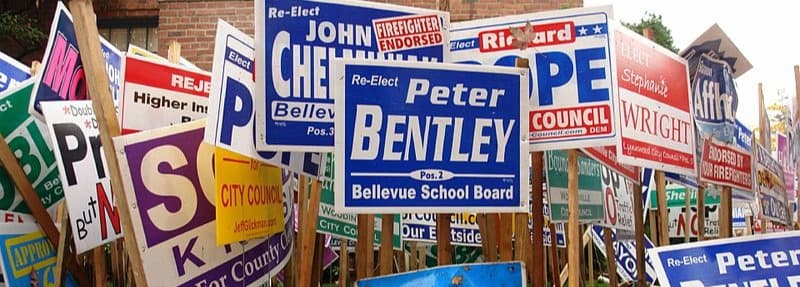
The Complete Guide to Yard Signs for Political Campaigns
What’s one of the most effective and affordable ways to capture the attention of voters? Yard signs. We see them everywhere during election season, and they’re one of the best ways that independent candidates can build name recognition within communities.
If you want to build awareness and keep your name at the forefront of your future constituents’ minds, well-designed and strategically placed yard signs can work wonders for your campaign.
Join us as we walk you through the steps necessary to create eye-catching, impactful yard signs for your campaign. We'll go over some practical tips and best practices, and we’ll even include notable examples of successful yard signs from past elections.
Why Yard Signs Work
Yard signs serve as mini-billboards that promote a candidate's name and message to the public. They can be placed in high-traffic areas, on residential lawns, and in public spaces (where permitted).
Here are a just a few reasons why yard signs are essential for political campaigns:
Visibility: Yard signs are a constant visual reminder of the candidate's presence in the race.
Name Recognition: Signs help voters remember the candidate's name when they go to the polls.
Community Support: Seeing yard signs in neighbors' yards can influence others to support your candidacy.
Low Cost: Compared to other forms of advertising, yard signs are relatively inexpensive.
They can even reach those elusive voters who avoid social media and television ads!
How to Create an Effective Campaign Yard Sign
Few of us are graphic designers, so the thought of creating a yard sign can be daunting. Fortunately, there are professionals who can work with you to craft impactful signage that will build campaign awareness without breaking your budget.
Step 1: Planning and Budgeting
First, you’ll need to do a little homework. Decide how much of your campaign budget you’re willing to spend on yard signs. This will help you determine the quantity and quality of the signs you can produce.
Make sure to check local laws and regulations regarding the placement of political signs. Some areas have restrictions on the size, location, and duration that signs can be displayed. In most polling places, there are laws regarding the distance and placement of any campaign materials.
Step 2: Designing Your Yard Sign
The design of your signs is one of the most important considerations. Make sure to:
Use Simple, Clear Messaging: The message on your yard sign should be straightforward and easy to read from a distance. Typically, campaign signs include the candidate’s name, the office they are running for, and sometimes a slogan.
Bold and Legible Fonts: Use large, bold fonts that are easy to read. Avoid using more than two different fonts on the sign to maintain a clean look.
High-Contrast Colors: Choose colors that contrast well with each other to ensure readability. Common color combinations include light text on a dark background or dark text on a light background.
Include Key Information: Ensure the sign includes your name, the position you’re running for, and a campaign website or social media handle if space allows. If your signs were paid for by a committee or other organization, you must disclose this information clearly at the bottom of the sign. You might also want to include the date of the election on your signs.
Visual Appeal: While simplicity is key, the campaign sign should also be visually appealing. Consider using a high-quality image of yourself or your campaign logo.
It’s important to test the visibility and impact of your sign before placing your final order. Print out a sample version of your design and place it at a distance to see how it looks. This can help you determine if the text is readable and the design is effective from a distance.
A rule of thumb is to use text that’s one inch high for every 10 feet of viewing distance. For example, if you want your sign to be visible from 30 feet away, the wording should be about three inches high.
Step 3: Choosing the Right Materials
The materials used depend on where your signs will be placed. Here are some considerations that you can discuss with your sign maker:
Durability: Yard signs should be able to withstand various weather conditions. Common materials include foam, which is good for indoor use, and corrugated plastic, which is durable and waterproof. Aluminum signs are very light and durable, so get a few if you have the budget.
Size and Shape: Standard yard signs are typically 24” x 18”, but they can come in various sizes and shapes. Larger signs are good for busy street corners, while smaller signs are best for residential placement. Ensure that your sign is large enough to be seen, but not so large that it becomes unwieldy.
Printing Quality: Choose a reputable printing service that can produce high-quality signs at an affordable price. Blurry text or images can reduce the effectiveness of your signs.
Step 4: Placing Your Yard Signs
The second most important consideration is where you’ll place your signs. You want to optimize visibility without adding to ground clutter. Place signs in high-traffic areas and near polling stations, and offer signs to supporters who live in visible locations. Provide signs to volunteers for placement in their yards across your community.
Keep in mind that too many signs in one area can overwhelm viewers and reduce the impact of each individual sign. Spread them out strategically throughout your community.
Pro Tip
Learn where blocs of undecided and independent voters are concentrated and strategically locate your signs there.
However, you should always get permission from property owners before placing signs on private property. For public spaces, ensure that you comply with local regulations.
It’s also bad form to get into a “sign war” with an opponent or their supporters. That means not trying to remove or block the visibility of another candidate’s signs. It’s inevitable that a few of yours may be moved. Simply replace them, if possible, and chalk it up to the cost of campaigning.
Step 5: Maintenance and Monitoring
Check your yard signs periodically to ensure they’re still in good condition and visible to passersby. Replace any that are damaged or have fallen down.
It’s important to make sure that you remove all signage after the election. Keep track of where they were placed to make sure there are no strays. In fact, some cities and states have regulations regarding the amount of time signs can remain out after election day.
In Washington, D.C., for example, signs must be removed within 30 days post-election. Kentucky law states that yard signs can be displayed no earlier than 30 days before any “special, primary, or regular election,” and they must be removed within a week after the election is over.
Check your local or state government’s website for the regulations in your area.
Best Practices for Designing Yard Signs
Campaign signs are impactful and affordable, but there are still some best practices to heed so you can gain the best advantage from your investment:
Keep It Simple: When it comes to political signage, less is more. A cluttered sign can be confusing and difficult to read.
Prioritize Readability: Your sign should be readable from a distance. Use large, simple fonts and high-contrast colors.
Consistent Branding: Use your campaign’s colors, fonts, and logos consistently across all materials, including yard signs.
Use Professional Design Tools: If possible, use professional design software or hire a graphic designer to create your sign.
Include a Call to Action: If space allows, include a call to action, such as visiting your campaign website or following your campaign on social media.
Comply with Legal Requirements: Ensure that your signs comply with all local laws and regulations to avoid fines and penalties. Although the Supreme Court ruled in 2016 that campaign signs are protected speech, there may be local regulations regarding size or placement in public spaces. For example, some communities allow political signs on the portion of grass between the sidewalk and roadside, but limit their placement in traffic circles and medians. There’s no federal law about signage at polling places, but many states have regulations that prohibit any campaign materials or electioneering within a set distance of polling stations’ entrances or exits.
Examples of Effective Political Yard Signs
There are many examples of political yard signs — both the good and the bad — and you can probably remember some from around your own community. Here are some memorable and effective signs from campaigns past:
#1: Barack Obama for America (2008)
The Obama campaign’s yard signs were simple yet powerful. They featured the iconic "O" logo with the American flag and either Obama’s name alone or Obama/Biden. Other signs featured his last name and various campaign slogans. The use of the bright blue background with thick white text made the signs highly readable and visually appealing.
#2: Bernie Sanders (2016)
Bernie Sanders’ yard signs were straightforward with a clean design. The signs featured Bernie’s first name in bold, white letters, sometimes underlined in red, against a blue background. The simple slogan “Bernie for President" appeared in smaller text below. The consistency in branding and color scheme helped in reinforcing his campaign’s message. There was also the iconic white outline of Bernie’s glasses and hair over the slogan “Feel the Bern.”
#3: Alexandria Ocasio-Cortez (2018)
AOC’s yard signs were notable for their bold design and use of yellow and purple colors. The signs prominently displayed Ocasio-Cortez’s name, image, and the office she was running for. The design was modern and eye-catching, helping her stand out in a crowded field.
You may notice a trend here. With the exception of AOC, these memorable signs feature a patriotic color scheme. The colors you choose for your campaign yard signs can either play into patriotic themes or go against the norm, helping your campaign stand out from the crowd.
Go Above and Beyond Yard Signs
Creating effective yard signs for your political campaign requires careful planning, thoughtful design, and strategic placement. By following the steps and best practices outlined in this guide, you can maximize the impact of your yard signs and enhance your campaign’s visibility and name recognition.
Remember, the goal is to create a memorable and easily recognizable sign that conveys your message clearly and concisely. With the right approach, yard signs can be a powerful tool in your campaign’s arsenal.
Want more tools to add to your toolkit? GoodParty.org empowers Independent and nonpartisan candidates across the country with free campaign tools. From voter insights to content templates, we have the resources you need to get your message in front of voters.
Photo by Josh Larios
Ready to learn more? Book a meeting with our team for a free walkthrough, or start exploring GoodParty.org’s campaign tools today.

